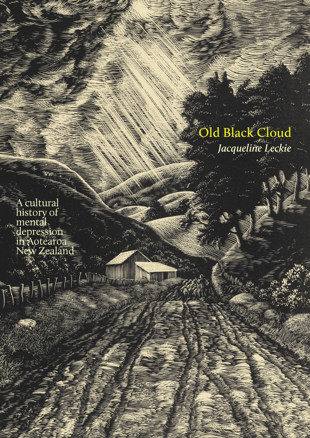Read an extract from Old Black Cloud: A cultural history of mental depression in Aotearoa New Zealand by Jacqueline Leckie on Newsroom:
‘Many of New Zealand’s artists, writers and musicians have given voice to the experience of depression and melancholia through their work. Meg Campbell (1937–2007) and her husband, Alistair Te Ariki Campbell (1925–2009) both suffered from depression but in quite different ways. Alistair Campbell, a prominent novelist, poet, editor and playwright, spent a few months in Porirua Hospital as a voluntary patient in 1960. As he recalled in an oral history interview in 2004, he “didn’t go over the edge, wasn’t psychotic, got close to it, I was never irrational — had a pain in my solar plexus — churning, churning away. Endless panic in the pit of my stomach. Didn’t really ‘go nutty’ at work. I kept it all under control . . . I was ill, I got through it and I found the experience interesting.”
Campbell was born in Rarotonga, Cook Islands, in 1925. His mother, Teu Bosini from Tongareva (Penrhyn atoll), had married his father John, a Cook Islands storekeeper and trader who was originally from Dunedin. Alistair’s depression may have stemmed from his childhood. In 1932, when he was seven years old, his mother died aged just 27, and a year later his deeply grieving father died from an undiagnosed illness. Alistair and his younger brother, Bill, left Rarotonga to join their older siblings, Margaret and Stuart, who were in the care of their grandmother in Dunedin.
She could not manage, and they were admitted to the Anderson’s Bay Orphanage, where Alistair lived for six years, attending the local primary school and then Otago Boys’ High School. He was clever, articulate, good at sport and good-looking. Still, he encountered racism. “I denied my Polynesian heritage and recognised only my European side. I was divided; and this was to land me in a psychiatric hospital. I came right when I recognised what had been troubling me.”
While he was a patient in the Porirua mental hospital Campbell wrote about the deaths of his parents and his brother Stuart, who had died in the Second World War. Sanctuary of Spirits, a 1963 poetry collection about the Māori of Pukerua Bay and Kāpiti Island and the Ngāti Toa chief Te Rauparaha, is also very sombre. His novel The Frigate Bird, published in 1989, depicts the crazed unravelling of the protagonist, who is travelling to his ancestral home in the Cook Islands, and was based partly on the diary Campbell kept during his first visit to Penrhyn in 1976, when he was mentally unwell. The diary was a ‘life-line’ to preserve his sanity.
Twenty-year-old Meg Andersen, a drama student, met Alistair Campbell, 10 years her senior and divorced from the writer Fleur Adcock, at a party in Wellington in 1957. Within a year she was pregnant, married and had abandoned her acting career. She was admitted to Porirua Hospital 10 times between November 1958 and 1979; for four of these she was committed, the other six were voluntary admissions. Each of her admissions — from five weeks to two and a half months — were of comparatively short duration compared to many patients and the time she spent with her family between hospitalisations ranged from three weeks to seven and a half years.’
Read the rest of the extract here.


